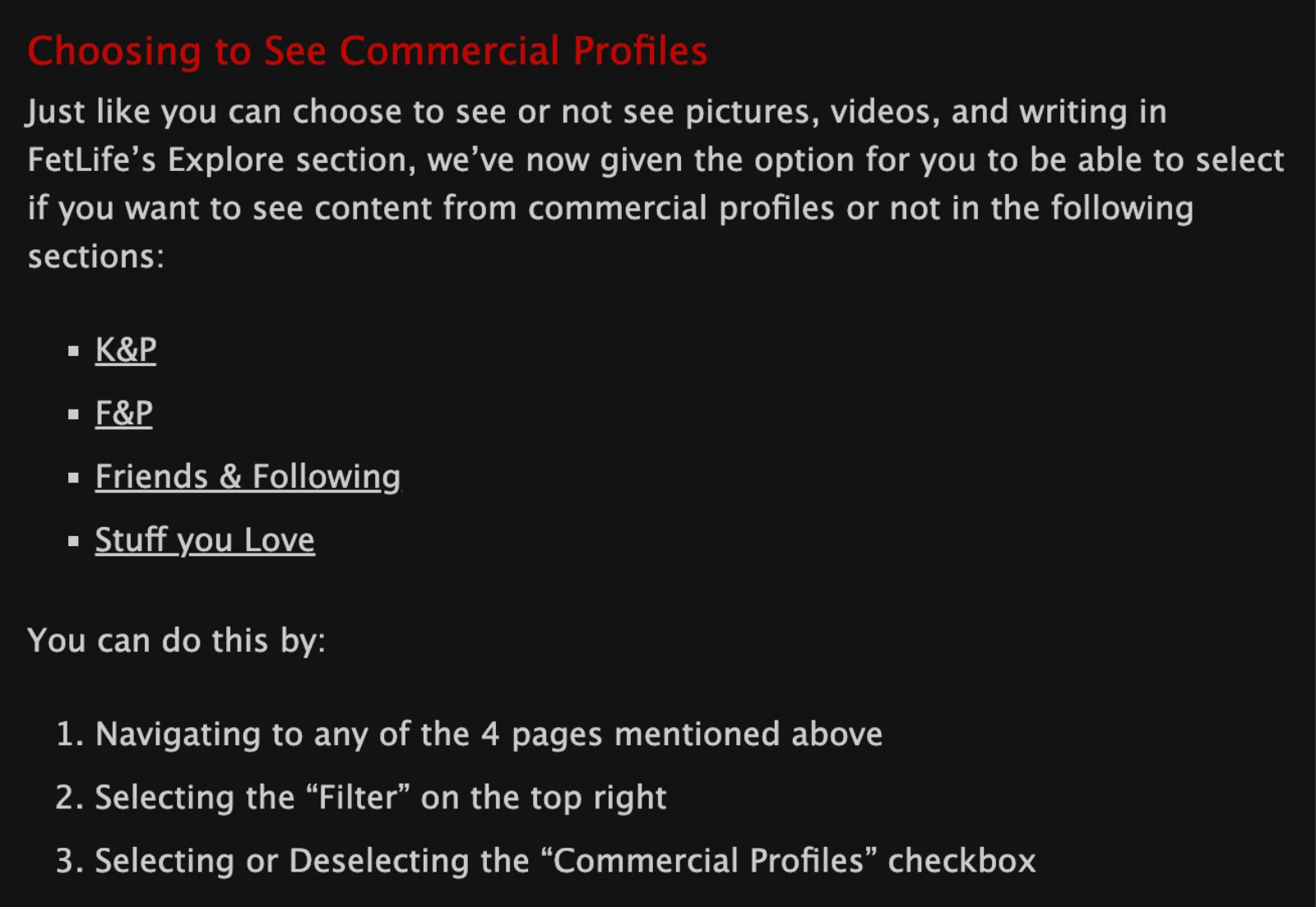FetLife has never been super friendly towards sex workers. Now, the fetish site is filtering out regular users that have been labeled “commercial.”
Olivia Snow is a writer, professor, and dominatrix. She’s currently a research fellow at UCLA’s Center for Critical Internet Inquiry, where she studies sex work, technology, and policy.
Despite so much of it being built by sex workers, the internet has never been safe for us. In a seemingly endless, tiresome cycle, sex workers pioneer new technologies and platforms until they become popular with the general public, who then unceremoniously eject us from our own spaces, until the process begins again.
The same pattern now seems to be unfolding on FetLife, the MySpace-esque social network for BDSM that has been one of the internet’s most popular fetish sites for over a decade. On July 27, FetLife announced it had rolled out a series of policy changes, including the option to limit what the platform refers to as “commercial profiles” from the feeds it displays on the site.
For those unfamiliar with the site, think of these feeds kind of like Twitter’s “Explore” tab—Kinky & Popular (K&P) is like trending topics, Fresh & Pervy (F&P) is new content, Friends & Following is your timeline, and Stuff you Love is your likes.
But it’s extremely unclear what FetLife considers a “commercial profile,” and even non-sex workers say they are finding that their profiles have been flagged—a process some compare to the practice “shadowbanning,” where social media platforms de-list sex workers’ accounts from search results without notice or reason.

A NOTICE TO FETLIFE USERS ABOUT A NEW FEATURE TO FILTER OUT PROFILES IT LABELS AS “COMMERCIAL”
Meanwhile, sex workers themselves have been largely absent from the conversation—because so many of us, fatigued by FetLife’s whorephobia and hostility towards us, abandoned the network entirely years ago.
With a faint glimmer of schadenfreude, I watched as FetLife’s announcement thrust users into the same position in which sex workers regularly find ourselves: forced to rely on anecdata and trial-and-error approaches to identifying if we’re shadowbanned and, if so, why. Unlike Twitter, which explicitly denies shadowbanning, FetLife at least admits to scanning and flagging content to artificially suppress it.
With many sex workers having long since left the site, the immediate response to FetLife’s announcement was confusion, primarily over what the term “commercial” even means.
Some users speculated that it may largely refer to profiles with links to OnlyFans pages, which was confirmed in June by FetLife’s Chief Operating Officer, who goes by the screen name R4mon, when the website was still working out the feature’s (ahem) kinks. Others quickly noted that this restriction could apply to leather and fetish gear designers, which R4mon also confirmed in a tech support discussion by noting the restrictions apply to “a wide range of commercial, so not just OF.”
Realistically, not even FetLife knows how its filters are applied, as is the case with most algorithms used by social media platforms and search engines. Even R4mon admits, “I can’t tell you exactly how it works.”

FETLIFE USERS ARE CONFUSED ABOUT CHANGES THAT LABELED SOME OF THE SITE’S MEMBERS AS “COMMERCIAL”
Generally speaking, algorithms refine themselves based on user activity that, without interference, codifies the biases of those users. While this boosts engagement metrics, it also results in algorithmic bias that, even if unintentional, impacts marginalized groups most severely—including, first and foremost, sex workers.
While FetLife claims not to be targeting sex workers specifically but, rather, “everyone selling a service or product,” it’s difficult not to come to the conclusion that FetLife, like most other social networking sites, is trying to excise us from their userbase—despite having already made it clear that our presence is unwanted. One pro-Domme told me, “FetLife has always hated sex workers, especially pro-Dommes.” Several others reacted to the website simply with disgusted facial expressions, with another pro-Domme remarking, “FetLife is where I’d go if I were a masochist.”
This form of content moderation is not new to FetLife. In 2017, founder and Chief Executive Officer John Kopanas announced that, after an unnamed financial institution ordered that its partnering banks freeze FetLife’s merchant accounts over alleged “illegal or immoral” content, the website would be eliminating its most controversial kinks (e.g., consensual non-consent, forced intoxication, and some forms of medical play) so that its payment processors might accept the platform back into their good graces. (Interestingly, Kopanas noted in the announcements FAQ that Coinbase, the cryptocurrency exchange widely considered to be a refuge for sex workers, had banned FetLife a year earlier.)
Unlike clip sites, which host and sell access to adult content, FetLife has a hybrid business model that depends on both advertising and selling $5 per month subscriptions that offer users special features and benefits. Albeit in vague verbiage, FetLife’s Terms of Use have already prohibited sex work by banning any content to “promote a session,” “post the schedule, price list or phone number,” or “solicit for clients on behalf, directly or indirectly,” with or of “phone sex operators, professional Dominants and professional submissives.”
The only exception is for designated sex worker-run groups—and even then, the platform does not allow users to “solicit or sell any sex acts for hire.” Like the state’s preferred nomenclature of “prostitution,” “sex acts” is likewise expansive and could apply to anything from vaginal sex to foot worship.
In most cases, sex workers are chased across the internet by the algorithms employed by financial institutions, social media networks, and their legal teams worried about the risks of allowing us to exist online. Deplatforming and shadowbanning have only gotten more severe in the past five years since the passage of FOSTA/SESTA, two bills aimed to silence sex workers under the guise of curbing human trafficking, which has accelerated our disappearance across the internet to dizzying speeds.
These bills have not gone unnoticed by the non-professional BDSM community, many of whom mocked the sex workers impacted by them, blissfully unaware that what happens to us tends to happen to other marginalized demographics next. In response to FetLife’s decision to flag “commercial accounts,” several users commenting on the announcement applauded the decision, with one user noting that “Backpages [sic] and the [Craigslist] personals section were shut down because of FOSTA-SESTA, and so the $camgirls, gold diggers, hookers and money grubbers all came running to sell their wares here.” Moreover, as another user added, “[Koponas] didn’t set out to build a solicitation engine.” To non-professional kinksters, our mere presence as sex workers endangers the platform.
The origins of FetLife are a typical internet startup story. Kopanas, a Canadian software developer who posts on FetLife as JohnBaku, built the website out of frustration with the vanilla dating scene in 2008. While better understood and comparatively accepted today, BDSM was not mainstream in the aughts. Like sex work, it was (and in many ways remains) largely stigmatized and, in some cases, criminalized.
In May of 2013, the American Psychiatric Association (APA) removed “paraphilia,” or “abnormal sexual desires,” from the fifth edition of its Diagnostic and Statistical Manual of Mental Disorders, or the DSM-5. Up until this iteration, BDSM and kink had been categorized as a mental illness, thus codifying existing stigma for doctors, lawyers, and lawmakers to weaponize against kinksters. Not only was it socially awkward to bring up kink; it was potentially dangerous, and only after years of activism from the National Coalition for Sexual Freedom (NCSF) did the APA reconsider its diagnostic codes.
FetLife offered a respite from the judgment of the masses who didn’t share our fondness for sensory deprivation, or impact play, or feet. But like the rest of the internet, the kinky social network did not embrace the most vulnerable of its users: sex workers and especially, in this case, pro-Dommes. FetLife remains a sort of graveyard, littered with faded relics and ghosts of sex workers who created profiles some years ago only to abandon them for less whorephobic spaces.
As multiple pro-Dommes told me, FetLife has been notorious for harassing dominatrixes since its inception in predictably heteropatriarchal ways, primarily cisgender male Doms attempting to date or out-dominate us, noteably in violation of BDSM’s foundational value of consent. My own experience on FetLife has been similar; while less vicious than its predecessor CollarMe.com, the userbase’s hostility towards women, sex workers, and Dommes specifically has driven many of us, myself included, off the website entirely.
To be fair, FetLife was never as hostile to sex workers as, say, Instagram, whose anti-sex work content moderation algorithms tend to flag images of people with certain body types—particularly women of color and fat women—and often catch vanilla profiles in their ever-expanding net. Other platforms like AirBnB have admitted to using AI to target sex workers and other “high risk” users who might use the service. This has led some sex workers to conduct independent research to determine which platforms they’re banned from, and why.
But while it’s unclear to what extent FetLife’s automated systems mirror those used by major tech platforms, it doesn’t seem to need them. FetLife is, like any vanilla social network, a community designed to exclude sex workers, who are often perceived as frauds masquerading as kinksters to exploit the BDSM community, rather than members of the community ourselves.
Following FetLife’s announcement, non-sex-working merchants have expressed similar sentiments and a desire to distance themselves from sex workers, with one noting in a comment under the announcement that “there is a huge difference between a profile used for commercial purposes and one that is for someone who is active intthe [sic] community and happens to have a shop for their crafty items or puts a link to their favorite bookstore on their profile.” Another user lamented that he had been caught up in the sweep for posting a CashApp link: “that doesn’t make me a ‘business account.’”
Regardless of how hamfistedly the mechanics of content moderation are applied, this heightened surveillance in an increasingly fascist political landscape should startle us all. Like attempts to limit sex workers’ visibility that preceded it, this policy will likely expand to apply to other vulnerable demographics: queer folks, people of color, and especially Black activists who have also faced targeted surveillance at a scale similar to sex workers.
But, as always, the sanitization of sex workers from digital spaces will likely go unnoticed until it’s too late—which is, after all, the goal of filtering our voices.
Update: A previous version of this article mistakenly cited the publisher of the DSM-V; it is the American Psychiatric Association and not the American Psychological Association. Motherboard regrets the error.


